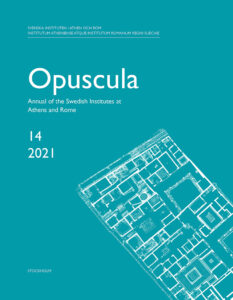 Opuscula 14 is published with open access. Printed edition distributed by Eddy.se AB. Also available at Amazon.com, Adlibris, and Bokus. View volume at ERIH PLUS.
Opuscula 14 is published with open access. Printed edition distributed by Eddy.se AB. Also available at Amazon.com, Adlibris, and Bokus. View volume at ERIH PLUS.
The topography of Hermione—A preliminary outline
By Henrik Gerding (Lund University, Sweden)
Abstract
The preliminary results of a survey of ancient Hermione (epichoric Hermion) are presented in this paper. The survey was conducted during three short campaigns over the period 2015–2017, and focused on the urban layout and development of the ancient city. Because the ancient city area more or less coincides with modern Ermioni, the investigation was mainly restricted to the documentation and analysis of architectural remains that were both still visible above ground and accessible. However, the report also includes a thorough re-evaluation of previous scholarship, taking into consideration remains that are no longer visible. The author identifies three questions of particular interest, relating to the exact location, extent, and potential relocation of the ancient city, and points to the lack of a coherent interpretation. On the basis of present data, the author proposes that Hermione was indeed relocated to a new site, less than 1 km away from its original position, in the early 3rd century BC, and highlights the urban, social, and religious consequences of such an event. However, pending further evidence, the suggested scenario remains a hypothesis.
Download PDF - Size: 773.76 KB - Downloads: 152 (since 2023)
Bibliographical information
Henrik Gerding, ’The topography of Hermione—A preliminary outline’, Opuscula. Annual of the Swedish Institutes at Athens and Rome (OpAthRom) 14, Stockholm 2021, 77-99. ISSN: 2000-0898. ISBN: 978-91-977799-3-7. Softcover, 478 pages. https://doi.org/10.30549/opathrom-14-06
Hermione. A Greek cityscape and its people
The section on Hermione, published in OpAthRom 14, comprises six articles:
Alcestis Papadimitriou | An ancient cityscape and its people: A study of ancient Hermione. Introductory remarks on historical sources and visible remains, archaeological research and prospects (pp. 65-76)
Henrik Gerding | The topography of Hermione—A preliminary outline (pp. 77-99)
Jesper Blid, with an appendix by Baukje van den berg | The Temple of Demeter Chthonia at Hermione (pp. 101-134)
Patrik Klingborg | The cisterns of the Bisti promontory at Hermione. With a preliminary description of the Roman aqueduct (pp. 135-155)
Angeliki Kossyva | Life and death in ancient Hermione. Excavations in the necropolis (pp. 157-167)
Jenny Wallensten | The key to Hermione? Notes on an inscribed monument (pp. 169-180)

No Comments
Comments are closed.